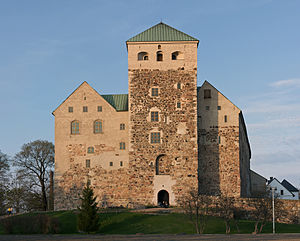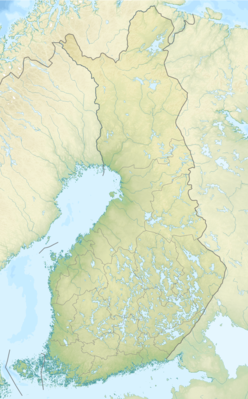Turku Castle
| Turku Castle | ||
|---|---|---|
|
The castle seen from the harbor |
||
| Alternative name (s): |
Turun linna ( Finnish ), Åbo slott ( Swedish ) |
|
| Creation time : | around 1280 | |
| Castle type : | Niederungsburg | |
| Conservation status: | Received or received substantial parts | |
| Standing position : | duke | |
| Construction: | Field stone | |
| Place: | Turku | |
| Geographical location | 60 ° 26 '7 " N , 22 ° 13' 42" E | |
|
|
||
The Turku Castle ( Finnish: Turun linna , Swedish Åbo slott ) dates back to the late 13th century and is the largest preserved medieval building in Finland . The castle is in its present form from a medieval main castle and a front castle from the Renaissance era. It is not far from the port at the mouth of the Aurajoki on the north side of the river.
location
A small island at the mouth of the Aurajoki was chosen as the location of the castle. Today the island has become part of the mainland because the sea level in Turku has dropped 3.5 meters since the year 1300 due to the uplift of the land . The location was strategically favorable because the castle was difficult to besiege. From the mouth of the Aurajoki, the shipping traffic on the river and the sea route to Sweden could be controlled. In addition, the castle served as a protection for the medieval city, which was around the cathedral , a good three kilometers away on the other side of the river.
history
founding
When present-day Finland became a permanent part of the Swedish Empire in the course of the 12th and 13th centuries , the Swedes began building castles in the newly gained area they called Österland to consolidate their rule. In addition to Turku, medieval castles were built in Vyborg (1293) and Hämeenlinna ( Häme Castle , late 13th century) and later in Savonlinna ( Olavinlinna , 1475). The construction of Turku Castle probably began around 1280. The brother of the Swedish King Magnus Ladulås , Bengt Birgersson , was Duke of Finland between 1284 and 1291 . During his reign, the duchy got into debt, which is probably due to the cost of building the castle.
middle Ages
In its original form, the castle was more of a fort . The models for the system were probably found on Gotland . The 59 × 38 meter rectangular complex was surrounded by a ring wall made of field stones. On the narrow west side and possibly also on the east side there was a squat gate tower , next to it there was a gate in the middle of the side walls. In the north-west corner stood the lord's residence, in the north-east corner a building that was used either as a warehouse or as a church. The Swedish troops who were trying to expand Swedish rule in Österland at that time could camp in the courtyard of the castle.
During the reign of Duke Waldemar Magnusson (1302-1318) the castle was converted into a closed castle. The main entrance was now on the east tower and the side gates were walled up. The walls and the west tower were raised, the courtyard was separated into two parts by a transverse wall. The five-story tower now served as a residential tower with living rooms on the third and fourth floors. In addition, further living and storage rooms were created. The plant was primarily planned for military use. From times, for example during the rule of the lord of the castle Mattias Kettilmundson (1324-1326), there was court life at the castle .
The castle was first tried in battle in 1318 when the Novgorod Turku people burned down. They could not conquer the castle. Magnus II was the first Swedish king to visit Finland in 1347 and 1351, where he resided in Turku Castle. 1364-1365 Turku got into the power struggle between Magnus II and Albrecht von Mecklenburg . After nine months of siege, the castle fell and was badly damaged by fire. Among other things, the fire destroyed the king's hall. In the course of the reconstruction, the facility was significantly expanded. With the construction of a south and north wing, the courtyard was now long and narrow, and a rifle gang was created on the top floor. The castle now had around 40 rooms and a chapel. In the course of the 15th century, the outer bailey was walled east of the main castle .
During the Swedish- Danish conflict of the 15th century, the castle changed hands twice: in 1441 it was conquered by Erik Axelsson Tott , and in 1448 it was regained by Karl Knutsson Bonde . During the reign of the Reich Administrator Sten Sture the Elder , the facility was expanded again at the end of the 15th century. The south wing was raised, in the north wing the imperial administrator had the Sture chapel built during his visit in 1495. A particularly important room in the period from the beginning of the 14th to the middle of the 16th century is the King's Hall. The construction is dated to around 1380. For two centuries it is considered the most important secular hall in Finland.
Modern times
King Gustav I. Wasa , who had released Sweden from the Kalmar Union and introduced the hereditary monarchy, visited Turku in 1530 and 1555 and resided in the castle. On these occasions the castle was repaired and rebuilt. In 1556 Gustav Wasa appointed his son Johann III. to the Duke of Finland. d. H. Varsinais-Suomi . John's residence time was the most glamorous era of the Turku Castle. After he married the Polish princess Katharina Jagiellonica in 1562 , she introduced a splendid court life at the castle in the style of the Renaissance period . As early as 1563, however, King Erik XIV had Turku conquered and his brother Johann kidnapped into captivity. In the end, however, the situation was reversed: Johann became king and had Erik imprisoned in Turku Castle in 1570.
The outer bailey , the walling of which was built in the 15th century, was given its present form between 1575 and 1588. The old wooden buildings within the outer bailey were replaced by brick buildings. In the period that followed, the outer bailey served as living space instead of the old, uncomfortable main castle. In the 17th century, the governors of the province and the governor-general of Finland, Per Brahe , resided in the east wing of the outer bailey and the Turku court in the north wing. The main castle was damaged by fire during a visit by the Swedish King Gustav II Adolf and was subsequently used as a warehouse and later also as a barracks . In 1705 the former ballroom in the south wing of the main castle was converted into a church.
From 1776 the Turku castle served as a prison. This fact is also due to the fact that linna ("castle") is a slang term for "prison" in Finnish. The Turku City History Museum has been housed in the castle since the late 19th century. In the summer of 1941, a Soviet bombing attack severely damaged the castle in the Continuation War . After the end of the war, restoration work began, which was completed in 1961.
literature
- Petya Aarnipuu: Turun linna kerrottuna yes kertovana tilana. Suomalaisen Kirjallisuuden Seura, Helsinki 2008, ISBN 978-951-746-983-8 .
Web links
- History of Turku Castle ( Memento of October 8, 2007 in the Internet Archive ) (Finnish)
- Turku Castle on Burgenwelt.org (German)


